BBC's Blog, page 14
July 18, 2013
What's on BBC Red Button - 20-27 July
It’s another jam-packed week on the BBC Red Button
this week with an eclectic mix of content for everybody to enjoy. From the
laid-back fields of Latitude Festival to solving crime with BBC’s Crimewatch,
find out how you can get the some of the best of the BBC straight to your
living room.
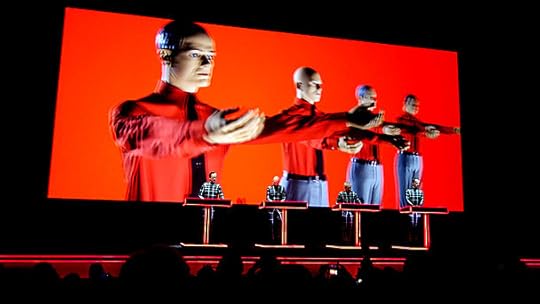
Kraftwerk
Latitude Festival 2013
Glastonbury and T in the Park may have passed us by,
but the festival season is still in full swing with Latitude ready to
reverberate through your eardrums on the BBC Red Button.
Coverage starts from Sunday evening where you can
catch highlights of German synth-pop legends Kraftwerk from 7.45pm.
Extensive highlights will cover a selection of acts from across the
weekend such as Bloc Party, Alt-J, Foals, Hot Chip, Yeah Yeah Yeahs and more.
Make sure you don’t miss it.
Available on all platforms
Kraftwerk
highlights
Sun 21st July - 7:45pm-2:00am
Highlights
Mon 22nd July - 7:00pm-9:55pm
Tue 23rd July -
4:00am-6:00am
Tue 23rd July -
6:00am-2:40pm
Tue 23rd July
-5:00pm-12:25am
Wed 24th July -
4:00am-6:00am
Wed 24th July -
6:00am-6:00am
Thu 25th July -
6:00am-4:20pm
Fri 26th July -
12:00am-6:00am
Fri 26th July -
6:00am-9:00pm
This week's sport highlights
Watch the latest live from The Open Championships at
Muirfield, with top pros such as Tiger Woods, Rory McIlroy and Justin Rose all
in action. You can also catch highlights as well as leaderboards throughout the
championships on BBC Red Button.
MotoGP fanatics can get their fix of the weekend’s racing
with qualifying live from Laguna Seca on Saturday 22nd July from
10pm.
There is also live Triathlon from Hamburg on Saturday
20th July from 2.50pm and rugby league fans - make sure you don’t
miss the Super League Show, which will be shown on the Red Button on Tuesday 23rd
July from 2.40pm.
Note that live sport event times are subject to
change. For more information on this week's Sport on Red Button, visit
the BBC Sport website.

Woody Allen
Imagine with Woody Allen
Join Woody Allen as he talks candidly about his childhood in Brooklyn, his
early fame as a stand-up in New York City and his first forays into
screenwriting and filmmaking. He discusses his prolific body of work, which
includes some of the most memorable cinematic moments of all time. Available on
Red Button on Wednesday 24th July from 12.25am until 4am.
Crimewatch
The BBC’s
crime-solvers need you! Crimewatch
needs your help to track down wanted faces. It’s your first chance to view and
report people wanted by police before the main Crimewatch programme. Will you
recognise anyone? Join the team on BBC Red Button on Thursday 25th
July from 7.55pm
Available on all platforms
Don't forget you can follow @BBCRedButton on Twitter.
Building the Breaking News Tool
I’m Niko Vijayaratnam, Senior Business Analyst for BBC News and today I want to tell you more about a new product (the Breaking News Tool) that we’ve developed for our News and Sport Journalists.
The BBC currently publishes breaking news online in a number of different ways. You can keep up-to-date with breaking news from the BBC while you’re on the move:
on your mobile via push notifications through the BBC News app on iOS and Android
on Twitter at @BBCBreaking
via SMS by sending ALERTS START to 82002
via Email
or by visiting www.bbc.co.uk and checking the latest breaking news displayed on the 'ticker' or as ‘site-wide-alerts’
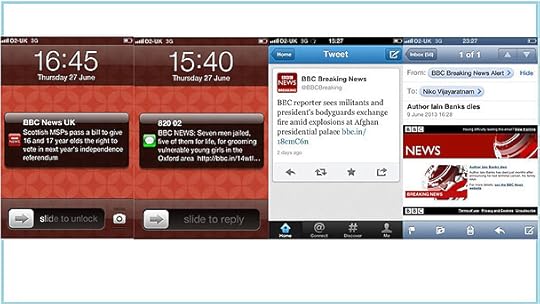
From left to right: examples of a breaking news push notification, SMS alert, tweet, email

A breaking news bar on the ticker (the red bar) on bbc.co.uk/news
The Breaking News Tool (BNT) is a new product we’ve launched this month which allows journalists to deliver breaking news alerts to you in up to six different ways at once. As the Product Manager for the BNT, I’ve been responsible for defining how this product should function.
Why did we build this tool?
The impetus for creating the BNT was that the process of publishing breaking news across the existing platforms involved using four different systems - This was inefficient as Journalists had to copy and paste breaking news lines between the different systems and the process often took much longer than it needed to. This in turn meant that we weren’t as fast as we could be at getting breaking news out.
The BNT solves these problems by allowing journalists to publish a single accurate breaking news line to multiple platforms at once from a single interface, therefore improving the speed and ease at which we can get breaking news lines out to you. It also removes the need to be trained to use multiple different systems.
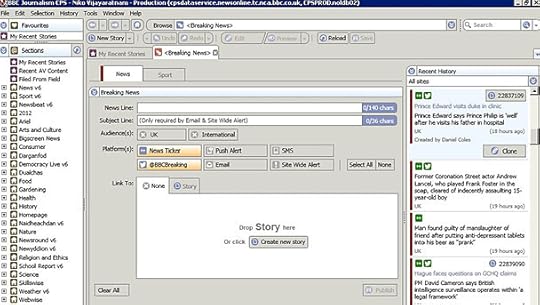
Screen shot of the breaking news tool
How does it work?
For most breaking news, once the BNT is open, the process of publishing an alert now simply involves:
1. Writing the breaking news line into the ‘News Line’ field,
2. Selecting the platforms we want to make the breaking news alert available on.
3. Selecting the audience that we want to receive the alert (on the selected platforms) i.e. people inside the UK, people outside of the UK (International) or everyone subscribed to breaking news alerts on the selected platforms.
4. Once we have made these decisions, we can simply hit the ‘Publish’ button to deliver you a breaking news alert.
The ‘recent history’ section on the right hand side tells us whether the alert was published successfully or not (i.e. the icons for the platforms we selected will go green to indicate a successful delivery, or red if an error occurred).
For some platforms (SMS messages, Emails and Push notifications), we have made the decision to mandate that alerts need to be linked to an article on bbc.co.uk so that when you receive an alert, you have an ‘onward journey’ to more information (if available) on that storyline. We haven’t previously included article links in SMS alerts before but given a large proportion of the audience now have an internet connected mobile phone, it made sense to provide a way to let you quickly find more information about the item of breaking news on the go.
As you might imagine, for some breaking news we won’t have an article ready to link the alert to. For this scenario, we’ve made it possible for Journalists to automatically generate a brand new article ‘on the fly’ from within the BNT. This means that we can give you the URL to an article on the developing storyline when you receive the alert so that you don’t have to wait, or go elsewhere, to find more information if you’re interested.

Article created from the Breaking News Alert in the content management system (CPS)

the article as it appeared on bbc.co.uk/news immediately after the story broke
The article linked to the alert will look as shown in the image above when you receive it (i.e. with ‘More to follow’ automatically included underneath the headline and summary) if you click on the URL before we are able to update the story with more detail but we aim to do this as soon as possible.
How did we build the Breaking News Tool?

Output of the kick off workshop
As with most projects, I started by asking the key stakeholders to agree on the vision for the product so everyone involved could be clear on the problem we were looking to solve. In this case my colleague Russell Smith, Development Editor for News defined the vision which was to ‘be able to publish a single accurate line on all platforms’ - this was something that we stuck to closely during the development of the BNT.
My next step was to hold a requirements gathering workshop with Russell, some of my colleagues from UX&D (User experience & Design), the Content Production System (CPS) team (the BNT is built within CPS) and News editorial (who would ultimately end up using the product). Having outlined the vision for the product, I embarked on capturing all of the requirements that the stakeholders had for the BNT - At the end of the requirements gathering workshop I asked the group to prioritise the requirements defined using the MoSCoW rating scheme (i.e. decide whether the requirements were ‘must haves’, ‘should haves’, ‘could haves’ or things we simply ‘won’t do’) - this helped to focus everyone on what we wanted the functionality of the product to include.
Once I was confident that I had captured all of the key requirements I drew up a “story map” to distill the requirements into the core features of the BNT, define the “minimal viable product” (MVP) and highlight the “minimal marketable features" (MMF). The intersection of MVP and MMF (i.e. the green boxes on the story map) defined the minimum portion of the problem space I wanted to solve in the first release of the BNT to deliver the required value to the end users.
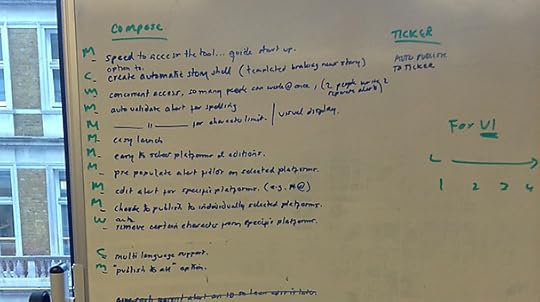
A whiteboard picture showing the output of the requirements gathering workshop

the story map
I engaged with the following third parties (who already provided services to allow us to deliver alerts as SMS messages, Emails, Push notifications and Tweets) and members of the CPS team to ensure that we could integrate the BNT with their systems to deliver alerts to the end platforms:
IMIMobile for SMS Messages
Comufy for Tweets (on Twitter)
Transversal for Emails
ProcessOne for Push notifications
Security was a key requirement for us so we needed to ensure that access to the API’s supplied by the third parties was limited to the BNT only.
Having assessed the technical feasibility of the project and with the scope of the product defined, I co-ordinated with our UX&D designers and developers within the CPS team (who are experts in building new interfaces in our content management system) to design the interface for the BNT. We began by honing the user workflow and compiling a set of paper-based and clickable prototypes which we could user test with our editorial colleagues to get early feedback on which ideas would work well and which wouldn’t. Sure enough, we had to make some changes, but by getting the product in front of the end users early we were able to incorporate the feedback quickly.
Once a final design had been settled on, I got down to writing the scenario based acceptance criteria which we would eventually test the product against. Writing the scenario based acceptance criteria any earlier than this would have wasted time as the designs were still in a state of flux.
Once the requirements had been defined and estimated by the CPS team, work on developing the product was scheduled and got underway.
Testing the BNT was a unique experience given the fact that we couldn’t actually test alerts on our production accounts without sending messages to you, the audience! Working with the third parties, we were able to set up test accounts and put in place safe guards on the production environment to enable us to test safe in the knowledge that alerts wouldn’t make it out to the audience until the BNT went live. Testing the end to end architecture was heart stopping at first!
I’m pleased to have been able to deliver this product and to see it used in Newsroom of our New Broadcasting House offices. We have had a positive reaction from the users and have seen an improvement in the journalist workflow i.e. it now takes around 2 minutes to write a breaking news line and publish it to all available platforms when previously, at times, it would take more than five times that time to achieve the same task.
We have also incorporated a section in the product for our colleagues in BBC Sport who will soon be able to make use of the tool to publish breaking news to the audience of some of their key outputs.
I hope this post has given you an insight into how, with products like the BNT, we are constantly striving to innovate behind the scenes to improve the way in which we deliver News online.
I look forward to being able to take the BNT further in the near future by integrating it with more outputs and potentially adding new features to further improve the workflow for our Journalists.
Niko Vijayaratnamis a Senior Business Analyst, News and Knowledge, BBC Future Media
—
Many thanks to Cameron Taylor, David Beaton, Purnima Thompson, Andy Gritton, Kirsty Brown and Russell Smith for their hard work on this project.
July 12, 2013
What's on BBC Red Button - 13-20 July
It’s another busy week for BBC Red Button as we continue to bring you the best of Britain’s music festivals with T in the Park coverage and highlights. We've also got all the MotoGP action from Sachsenring and the Women’s Euros in Sweden, plus chef Rick Stein's expertise and behind-the-scenes extras from CBBC's Wild.
T in the Park

Calvin Harris live
With Glastonbury done and dusted it’s time for Scotland to do its stuff. Yes, it’s T in the Park weekend again! Click the Red Button to get access to extended coverage, full sets and uninterrupted music from three stages at T, as well as tracks from some of the stars of the future performing for BBC Introducing.
This year, the big-hitters include the likes of Mumford and Sons, Rihanna, The Killers and Calvin Harris as well as seasoned performers such as Dizzee Rascal, Emile Sandé, Calvin Harris and David Guetta. No Scottish festival would be complete without popular local acts and this year Deacon Blue, The Proclaimers, Texas and Travis provide the colour.
Tune in from Friday 12 July to Sunday 14 July to watch live and relive the experience with extended highlights and full sets during the following week.
Available on all platforms
Full sets
Sat 13 July 4pm – 2am
Sun 14 July 2:30pm – 2am
Highlights
Mon 15 July 7pm – 9:55pm, Midnight – 7am
Tue 16 July 4pm – 7pm, 11:45pm – 7am
Weds 17 July 1pm – 4:45pm, 8:15pm – 9am
Fri 19 July 11:30pm – 2am
This week's sport highlights
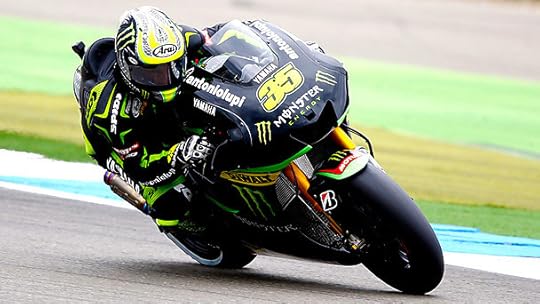
MotoGP - Cal Crutchlow
Wimbledon has been and gone but there is still a variety of sport to follow on Red Button. We’ve got the MotoGP qualifiers from Sachsenring, the Moto2 and Moto3 races and MotoGP extra this weekend. We also have coverage of the Rowing World Cup from Lucerne, Switzerland where Team GB will be in action.
Note that live sport event times are subject to change. For more information on this week's Sport on Red Button, visit the BBC Sport website.
Rick Stein’s India
One of the highlights of Rick Stein’s visit to India was the chance to meet the Dalai Lama in Himachal Pradesh high up on the foothills of the Western Himalayas. This is a great opportunity to see some more highlights of their chat on that memorable day.
Available on all platforms
Sun 14 July 2am – 7am
Mon 15 July 2am – 7am, 9:55pm – 4am
Tue 16 July 4:10pm – 5pm
Wed 17 July 4:10pm – 7:15pm
CBBC Wild Extra
Dive behind the scenes of CBBC’s brand new show Wild. Join Katie and Dodge on location for a barrel of exclusives. See how the team put the live show together, get a sneaky peek at the next episode and join presenter Naomi Wilkinson as she takes on a terrifying challenge. Not to be missed if you like living life on the wild side.
Available on all platforms
Sat 13 July 7am – 11:20am, 3:05pm – 4pm
Sun 14 July 7am – 9:45am
Mon 15 July 7am – 4:30pm
Tue 16 July 7am – 4:10pm
Wed 17 July 7am – 1pm
Don't forget you can follow @BBCRedButton on Twitter.
July 11, 2013
BBC iPlayer App on Android: Update
My name is David Berlin and I’m responsible for the BBC iPlayer mobile application on Android.
Last year Dave Price, Head of TV & iPlayer wrote about the importance of the Android platform and how we are focusing on three key areas to improve the BBC iPlayer experience for audiences with these devices:
As a reminder, my team have been focusing on:
1) Achieving video playback quality parity with Apple iOS devices
2) Supporting the full range of Android screen sizes, including tablet support
3) Delivering mobile video downloads to Android devices
I'd like to give you an update on how we are delivering against these goals.
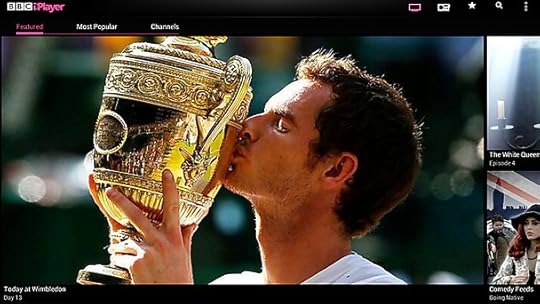
How the home page should look on a ten inch Android tablet
First stop - matching video quality
We’ve been gradually improving the video quality we serve over Wi-Fi to all Android devices, and had focused on delivering comparable (to iPad/iPhone) quality media to the 75% of you on our most popular devices. On Tuesday we flicked a switch in MediaCityUK, Manchester, which enabled those higher quality streams on all of our most popular Android phones, tablets and ‘phablets’ that can handle them.
Second stop - supporting a range of screen sizes, including tablet support
With higher quality playback achieved on the most popular Android devices, we then moved on to addressing support for a range of screen sizes.
Since the Android app launched in February 2011, tablets larger than 7.1” have been able to install BBC iPlayer from the Android Market/Google Play. However, when you tapped on the icon on your device home screen, it launched the BBC iPlayer mobile website.
With requests from tablets now making up around 20% of total iPlayer video requests each month, and larger tablets making up the majority of those requests, we wanted to focus on supporting these devices first. We know that more and more of you are using your tablet like a personal TV – and want the benefits that an app can bring (such as mobile downloads – coming later this year) on these devices. That’s why, a month ago we released an update to remove the website link and delivered the BBC iPlayer app to all Android phone, tablet and phablet device sizes (more than 3,000 different models).
Third stop - mobile downloads
Prior to delivering mobile downloads, we felt it was critical to put these two building blocks of quality playback and support for larger tablets in place. Today we have an Android development team that is almost 3 times the size of the iOS team. Over the past months this team has made excellent progress building the downloads feature, and with 100% of the team now entirely focused on downloads we’re looking forward to accelerating the delivery and launching asap.
We appreciate the frustration the Android community has been experiencing in the time it is taking to deliver this desired feature, but I hope this provides a little more context around the complexities involved.
I read app store comments on a daily basis and try to work out the cause of the issues that some devices on certain OSs are experiencing. I’m always interested in feedback so please share your thoughts and comments below.
David Berlin is Senior Product Manager, TV & iPlayer Mobile Applications in BBC Future Media
Xenon Embedded Media Player
I’m Gareth Jones, a software engineer at BBC TV and Mobile Platforms.
At the end of November last year the BBC launched the Connected Red Button service on Virgin TiVo along with updated versions of the iPlayer, News and Sport apps. This package also consisted of a fifth release: an application that is both integral and vital to each of the above apps, yet few are even aware of its existence!
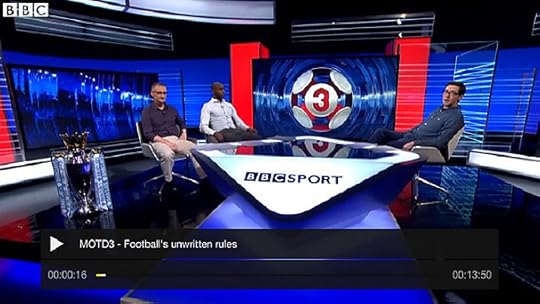
Xenon player in action
Xenon is a brand new embedded media player that was developed specifically for AS2 embedded devices such as Virgin’s TiVo, to be used by applications like iPlayer, News, Sport and any other such applications that the BBC develops in future.
The development of a new player was actually driven by Connected Red Button. The CRB project was subject to some aggressive performance requirements that were going to be difficult to achieve even with an ideal setup on the modest TiVo hardware, but impossible with the existing media player.
EMP as it was known had been built years before to a different set of requirements and for a different platform, and really wasn’t optimised for this environment. If we were going to stand a chance of meeting CRB’s performance requirements then we’d need to build a new player from scratch.
A new beginning
Xenon is based on an MVCS pattern with separate services performing the important tasks of reading playlists, parsing server responses, loading subtitles and streaming the media itself, while dedicated views handle the presentation to the user. It can be used both by standalone applications and those that are based on an AS2 framework of ours: the benefit of the latter being that the host application can then take advantage of the framework’s underlying automated behavioural testing functionality.
Inbound communications are provided by an API that the host application (i.e. iPlayer) can use to control everything from the desired media bitrate to subtitle preferences in real-time, while an events system to which the host can subscribe is used for all outbound communications. This events system provides the host application with around 70 different events, though only 20 of them are required for “normal” use: the others are either used for debugging, were included in order to support possible future requirements or are there simply to provide the host with more specific information on given scenarios.
The project is covered by around 200 unit tests which not only provide confidence in the existing code but will also provide future engineers with a means to test any additions or refactors.
So what’s new?
Viewers should notice a significant improvement in performance, some of which are covered by the following statistics:
• Media load times have been halved
• Video scrub times are now 3-4 times faster
• Toggling between SD and HD is now 3-4 times faster
• Subtitles load times are improved tenfold down from 30-40 seconds to just 3-4 seconds.
In order to achieve this kind of performance we had to employ a number of tricks!
One of the things we looked at was the process by which the old player would select and then connect to a server. We were interested in improving this because we’d noticed that there was a noticeable delay between getting the list of stream locations from the server and the start of playback.
It turns out that EMP would make multiple connection requests to its chosen location using different ports – 1935, 80 and 443 – the standard Flash Media Server (FMS) ports. When one connection responded favourably the other two were closed and the stream was requested from the open one.
Trying to avoid the delays associated with working through a list of ports in series by trying them all in parallel would be worthwhile if each port had a shared chance of success, and on a platform like the PC which operates on different types of networks with different routers and firewalls that’s most probably the case.
On TiVo however, unless there’s a serious problem with the chosen content delivery network (CDN) the 1935 connection will work 100% of the time and if it doesn’t work then we’re better off trying a different CDN than the same one again on a different port.
So that’s what Xenon does: if the single connection request on port 1935 to its first CDN fails to connect then it moves on to the next and sends another single connection request to that on the same port. If the user is unable to connect to a single CDN then either their internet connection is down or they have bigger problems because each CDN has a lot of failover and redundancy.
This approach means the box only has to allocate enough resources to create and connect a single NetConnection which means more resources are available elsewhere to help deliver a more responsive user experience.
Another thing we looked at was subtitles. The old player took 40-60 seconds to resume playback after subtitles were enabled and we really wanted to bring this figure down.
When we looked at how subtitles were being handled in EMP we discovered that typed objects with verified data were being created as soon as the file was downloaded and parsed. A 60-minute program with lots of talking might contain hundreds of lines of subtitles which would require a fair amount of work to get through. Again such an approach makes sense on a PC but not so much on a set top box.
The way we got round this in Xenon was to download and parse the XML file as before, but to create only basic reference objects at first without typing or validation and to defer such calculations until the reference object was relevant to the stream based on the current playback position. At this point the object’s data is verified and converted into a more usable format before the subtitle is displayed on-screen.
This approach means a little more work is done by the player for each individual subtitle as playback progresses, but it also means we can spread the necessary calculations over the duration of the program rather than doing them all up-front which allows us to resume playback in just 3-4 seconds.
What it means for us
Some specifications and supported features are as follows:
• The project weighs in at around 6,000 lines
• Both audio and video streams are supported, both live and on-demand
• Akamai, Limelight and Level3 CDNs are supported
• Dynamic CDN switching and ABR1 bitrate downswitching are both supported
• Dynamic connection weighting and prioritisation is supported
The new player also provides a number of benefits for our development teams:
• An API that allows direct control of every aspect of the player at runtime
• A comprehensive and consistent events system which makes debugging quick and easy
• A complimentary example application that both provides new teams with an implementation template and a convenient way for us to diagnose issues with the live service
• The codebase is extensively covered by tests which provides confidence in the robustness of the code.
Although invisible to the average user, Xenon seems to have gone down well with the public with positive reviews highlighting improved speed and reliability.
If you have any questions about Xenon please leave a comment below.
Gareth Jones is a software engineer in the TV Platforms team, Programmes and On Demand, BBC Future Media
July 9, 2013
Glastonbury: The Digital Hub
Hi, I’m Nick Pinks, and I’m one of the team of people that brought you the BBC’s most comprehensive coverage of Glastonbury ever – with live streams broadcast from 6 key stages, 120 performances live and on demand, and 250 hours of coverage all available whenever and wherever you wanted. Whether that was sneaking a look on the PC in the office, on the bus on your mobile or tablet or via your connected TV from the comfort of your sofa – we brought you closer to the festival action than ever before.
My colleagues Sam, Jen and Jem all blogged before Glastonbury and talked about how we were going to bring you a festival on this scale. But, after an astounding weekend, where even the mud stayed away (mostly) from the fields of Worthy Farm, I wanted to share with you how teams across the BBC came together to deliver the first digital Glastonbury.
The BBC’s Digital Glastonbury hub
During the weekend, we turned the BBC’s R&D South Lab in Shepherds Bush into the production hub for the BBC’s Digital Glastonbury 2013, and along with the team on the ground at the festival and colleagues in MediaCity UK in Salford, gave you unprecedented coverage from the festival.
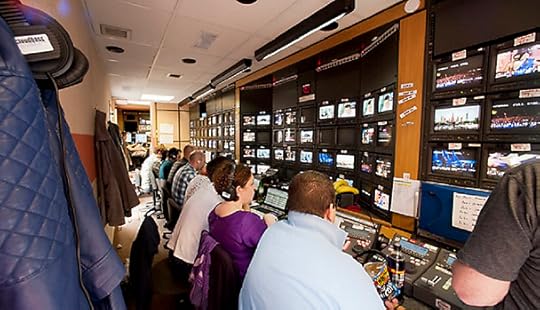
Monitoring output in the Glastonbury Digital Hub
This was the culmination of months of planning and preparation, bringing teams and technologies from across the whole of the BBC together in a way that hasn’t really been tried before and certainly not at this scale for a live music event. In essence we put a whole festival together in our labs with colleagues from Radio & Music Multi-platform, Future Media, News Location Facilities, Broadcast Systems Development, Sport Multi-platform and Music Television (plus volunteers from other teams such as Finance and Marketing).
In order to keep costs down,we turned the whole production process upside down. Instead of sending many of the team to a muddy field in Somerset, we used the latest connectivity to get all the coverage back to a BBC base, and then brought the necessary producers, editors, compliance experts, bloggers and everyone else together in the R&D base in London or in Salford. The immediate benefits are pretty obvious - lower travel and accommodation costs and a readymade office and production environment for people to work in, plus the ability to use our own existing networks and systems to move all the content around as it’s checked, edited, transcoded, and loaded up to be watched. What maybe isn’t obvious is what sort of a ‘thing’ you make when you invite the whole of the online coverage of the largest greenfield festival in the world into a building that day to day is a technology R&D lab.
Lets take a look
First of all we took over a fair chunk of the car park with an OB (Outside Broadcast) truck which housed the editors for the red button live streaming output for the weekend.
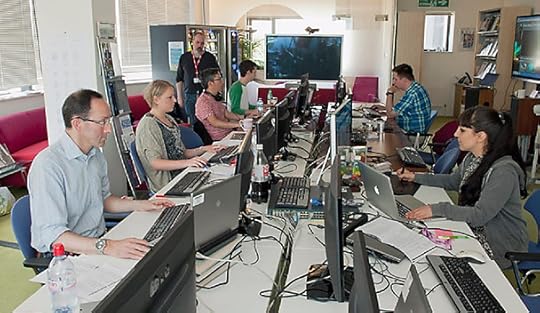
Live bloggers, site editor and picture editor in action in the Glastonbury Digital Hub
Up on the 3rd floor, we had the compliance area, where the live feeds from the Glastonbury stages were monitored for editorial content by staff from across the BBC. Compliers had their fingers hovering over a range of buttons that would trigger anything from an on-screen apology to an immediate cut of the video feed, which thankfully was rarely needed. The output from this team then went directly up to Salford via a combination of video circuits and new BBC built StageBoxes, to be encoded by the same systems which brought you the Olympics and, that same weekend, were bringing you online streaming of Wimbledon and the Formula 1 action from Silverstone.
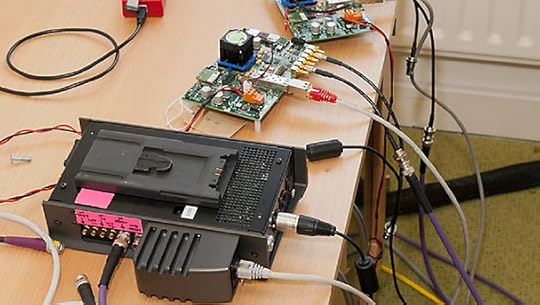
Stagebox in action
Just around the corner from the compliance area, in what usually serves as the library for R&D, we packed together the social media team that would be live blogging, tweeting and sharing images and information across the BBC’s platforms. And, not only were those guys watching the live unedited feeds from all the stages, but they were hearing the compliance guys talking about the performances, getting the backstage chat from the editors, hearing and seeing all the other bloggers social media activity, and, in a really exciting first time deployment, they were seeing real time page visit stats of all the BBC’s online coverage of the festival. No one has really done this in the BBC before - fed real time stats for access straight back into an element of the production team - and in a way it was like putting the production team right in the middle of the audience. Pretty appropriate for a festival really!
Meanwhile, as all this activity is going on real time, there was also all the offline, catch-up, on-demand production going on too (told you we were busy!). Editors would be reviewing each set as it finished and using special BBC-built tech called ‘Raven boxes’ to assemble digital packages to go out on the all the different channels. And just remember, they were doing that right next door to where all the real time conversations on social media were going on – via the live blog, Twitter and Facebook, along with the team that were complying the streams. Never before have editors had such a close understanding of what their audiences need, almost without having to ask. The only way we could have given them a better insight was to have plopped them down with their edit kit in the middle of the mosh-pit at the festival.
Another team then uploaded these videos to the BBC Glastonbury site, BBC iPlayer (and selected clips onto YouTube and other syndication) so you could catch up on those Glasto moments you'd missed. And yes – you guessed it - the guys loading up the videos, with all the metadata, were sitting there amongst a crowd of people who have essentially created a tiny satellite Glastonbury right here in sunny Shepherd’s Bush. So they know exactly what the demand is, exactly what the key words that people will be using to search for it will be.
How long did this all take? Well normally you would expect the upload to be an overnight job. However thanks to the massively improved workflow and months of planning, pretty much everything was done and dusted by 3am each morning, a huge improvement in performance. And, due to the project's collaborative nature and the way the technology was tested and deployed, we delivered the most immersive, responsive and electrifying digital festival ever.
Your feedback
The feedback so far has been fantastic. We saw huge numbers of you tuning in to the BBC’s Glastonbury coverage online and via the red button with a record 1.5 million unique browsers to the BBC’s Glastonbury content throughout the weekend. You seemed to love watching it on the go, with 42 per cent of total traffic across the weekend from mobiles and tablets. Over 6.2m of you pressed red over the weekend, up by 77 per cent compared Glastonbury 2011. And no surprise, the legendary Rolling Stones performance on Saturday night was the most watched with over 700,000 requests (and growing).
We like to hear how we can improve our coverage again for next year, so please leave a comment below. I’m already looking forward to Glastonbury 2014 and thinking about how the BBC can improve its digital coverage.
Nick Pinks is a Technology Transfer Manager in BBC R&D
July 5, 2013
What's on BBC Red Button 6-13 July
After a mammoth week of Glastonbury, Wimbledon and the British GP, the next seven days on the Red Button show the pace has no sign of slowing. Action at SW19 always goes by in a daze of shocks, strawberries and Sue Barker, so catch your breath and enjoy the chance to relive the highlights. Plus Rick Stein’s food adventures in Indian continue as does the summer festival season, with T in the Park.
Rick Stein’s India
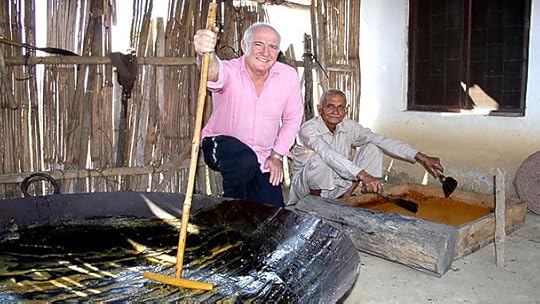
Rick Stein's India
Rick’s journey delving into the melting pot of Indian cuisine continues with excerpts from episode four. The chef arrives in the city of Lucknow, reputed to be the curry capital of India (possibly the world?). Once a city governed by powerful Muslim rulers, Lucknow chefs earned a fortune creating dishes that would fill their rivals with envy. Reliably informed that the local fare is the ultimate party food, Rick joins thousands of partygoers as they enjoy Eid. Further north in the Punjab, the chef observes the age-old process of making jaggery and is recruited as a guest judge to find Punjab's new 'Star Chef'.
Available on Freesat/Sky/Virgin Media/Freeview
Mon 8 July 9.55pm-6am
Tues 9 July 6am-7am
Wed 10 July 4.10pm-5pm
Fri 12 July 4.10pm-5pm
Sun 14 July, 2am-6am
How to be a powerful woman

Powerful women: Tanni Grey-Thompson, Alexandra Shulman,Tracey Emin and Shami Chakrabarti
Successful women including Tracey Emin, athlete Tanni Grey Thompson, and Vogue editor Alexandra Shulman share their experiences, advice and philosophy for achieving more at work. In 15 short films, the high-flying females who were all featured on Woman’s Hour Power List 2013 offer tips about how to stay ambitious, resilient and connected in business while seeking to achieve that often elusive work/life balance.
Available on Freesat/Sky/Virgin Media/Freeview
Tues 9 July 10.45am–3.45pm
Wimbledon Highlights
It has been one of the most unpredictable two weeks in the tournament’s history, with a succession of shock defeats for favourites Rafa Nadal, Roger Federer and Maria Sharapova. With replays of the women’s and men’s finals alongside tournament highlights, relive the moments which have ensured this year’s competition will be remembered long after the doors shut at the All England Club.
Note that live sport event times are subject to change. For more information on this week's Sport on Red Button, visit the BBC Sport website.
Behind the scenes of CBBC's Wild
This week CBBC Extra is diving behind the scenes of CBBC’s brand new show Wild. Join Katie and Dodge on location for a barrel of exclusives. See how the team put the live show together, get a sneaky peek at the next episode and join presenter Naomi Wilkinson as she takes on a terrifying challenge. Not to be missed if you like living life on the wild side.
Available on Freesat/Sky/Virgin Media/Freeview
Tues 9 July 7am–10.40am, 3.45pm–7.30pm
Wed 10 July 7am–4.10pm, 5pm–9.30pm
Thurs 11 July 7am–9.30pm
Fri 12 July 7am – 4.10pm, 5pm–7.30pm
Sat 13 July, 7am-11.20am, 3.05pm-4pm
Flintoff roadshow
Mark Chapman, Andrew ‘Freddie’ Flintoff and special guest Glenn McGrath present a special Ashes Roadshow, live from Nottingham ahead of the first Ashes Test against Australia.
Available on Freesat/Sky/Virgin Media/Freeview
Monday 8 July 7pm–9pm
T in the Park

Rihanna will headline at T in the Park
Scotland’s biggest music festival gets under way on Friday, with Rihanna and the Killers among the headliners. Fresh from their Glastonbury set, Mumford and Sons also feature on the bill. Not been lucky enough to get tickets? Fear not, Red Button has it covered. Enjoy live music and highlights across the weekend and feel smug about revelling in the festival feeling from the comfort of your living room.
Available on Freesat/Sky/Virgin Media/Freeview
Fri 12 July–7.30pm–2am
Sat 13 July – 4pm – 2am
Don't forget you can follow us on Twitter at @BBCRedButton. For answers to frequently asked questions about BBC Red Button, see our information page.
Goodbye!
Hi everyone,
This is a quick post to say a thank you and a goodbye as my time on the Internet blog has now come to an end. It’s been a fascinating nine months where the blog has covered some really meaty content, not to mention a new look design!

Some of the new features introduced on the Interent blog earlier this year
I hope you’ve found some of the posts I’ve published over this time informative and interesting and that they’ve given you a bit of insight into the workings of BBC Online. Here are some of the highlights:
New features for BBC Sport were covered in depth including the iPhone app launched in January, followed by the android version the following month. Sport had a full desktop refresh and launched a responsive version of their mobile site.
Executive product manager Matt Coulson blogged about the launch of Connected Red Button on TiVo while we heard from the senior UX designer about how his team designed the site. Technical lead Duncan Fortescue blogged about how it was built.
Linked data was a major theme on the blog over the last few months with posts including Linked Data: Connecting together the BBC's Online Content by Oliver Bartlett, the launch of the News Juicer and the News linked data Onthology along with the release of the Storyline Data model
Changes in the BBC's Knowledge and Learning product were well covered including the release of the new Beta site as blogged by executive editor Chris Sizemore and we heard in more depth about how the site was built from technical architect Rob Lee. Further changes to K&L included the closure of the Health Website and the launch of BBC Food Your Favourites (including the closure of the recipe binder feature).
That’s just a whistle-stop sample of some of the content we’ve covered, I hope you have found some of it enjoyable and useful.
Thanks and bye!
Eliza Kessler was the content producer on the Internet blog.
July 4, 2013
Eight challenges to measuring off site social media performance
I’m an Audience Researcher within BBC Future Media, which means I contribute to my department’s remit to measure product performance, understand audiences’ attitudes and behaviour and provide recommendations to inform decision-making in the future.
One of the areas I work across is social media; an area that continues to grow in visibility and importance. As Holly Goodier blogged last year, 77% of the UK online population now actively participates on the internet using social tools.
The likes of Facebook and Twitter get a lot of attention, but social media extends beyond social networks to include functionality such as commenting or sharing that can make any website, including BBC.co.uk (and indeed this very page), social.
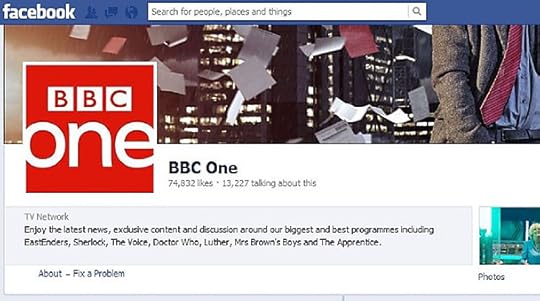
BBC ONE's Facebook page
However, for the purposes of this post, I will focus upon off-site activity – that which occurs outside of BBC.co.uk.
Off-site social media is a great way to reach and connect with our audiences, and as such we operate many accounts across our channels, brands and divisions to accomplish this. The majority of our accounts are within Facebook and Twitter, but several of our programmes and services also have a presence on sites such as Google+, Instagram, Pinterest, Tumblr and YouTube.
Watching our teams use these different environments in multiple ways is fascinating, but it also creates challenges when it comes to measuring how we are performing.
Listed below are eight challenges we face when assessing social activity, both directly related to our official presence and in terms of wider online conversations. Not all of these are limited to social media, and few if any are BBC specific, but they give an idea of some of the considerations we face:.
1. No official measurement source: TV has BARB and Radio has RAJAR – two well established bodies, with consensus on the most appropriate metrics to use. Within digital, there is the relatively new UKOM - while it offers a range of measures, it does not break down social media into specific accounts (such as @BBCSport on Twitter or BBC One on Facebook). Social networks may offer useful insight tools themselves, but only top-level information is made public. It can therefore be difficult to place performance in the context of the performance of other accounts or organisations.
2. Limited geographic restrictions: I work within the public sector side of the BBC, and so am principally interested in UK performance rather than global. Again, insight tools can offer geographic splits but there isn’t much publicly available UK-specific data to compare to.
3. Aggregating across multiple accounts: It can be difficult to assess overall performance when multiple accounts are being used – for instance, if we wanted to measure combined performance across @BBCBreaking and @BBCNews on Twitter. Action-orientated metrics (such as measuring the number of ‘likes’ or views) can be added together, but others such as total audience cannot, since people that follow multiple accounts would be counted more than once unless data could be de-duplicated . The challenges of measuring your own organisation are magnified when trying to measure others.
4. Totalling activity across multiple services: The ideal would be to evaluate our performance across the entirety of social media, but different services with different functionalities with different ways of measuring make this impractical. For instance, is a Facebook share the equivalent of a Pinterest re-pin?
5. Distinguishing active from lifetime audience: Metrics such as followers or likes are based on lifetime activity – they take no account of recency and so could count activity from several years ago. Changes over time can be used to assess growth, but it doesn’t give an accurate reflection of the active audience – people that interacted with the site more recently (e.g. in the last week or last month). Again, some insight tools offer this function, but once again there is an inability to place performance in context.
6. Interpreting behaviour: Adding up the number of comments or mentions produces a measure of audience engagement, but it assumes all interactivity is good when in fact audiences could be using social media to protest against something or talk about how much they hate a particular programme. Sentiment analysis can provide some context. While tools continue to improve and innovate, ambiguities in tone and meaning mean that analysis is not yet fully accurate
7. Identifying relevant activity: Counting the volume of mentions for a programme across social media could be limited to searching by the programme name, or it could include a search for mentions of the on-air talent, topic or notable incidents. Furthermore, that on-air talent can appear across multiple programmes or formats. Agreeing on parameters can be hard to do. Some tools do automate this to provide a consistent view for all users, but without an industry standard it is still possible for other organisations to announce radically different figures due to different measurement criteria.
8. Measuring impact: Metrics such as likes or retweets are not ends in themselves, but are signifiers of audience engagement. Social media objectives should be broader than stimulating this type of behaviour alone, and could have goals such as increasing the audience figures for a TV or Radio programme or raising positive opinion towards a programme, channel or service. This is something that is hard to measure in any medium, but the nature of social, where ease of interaction encourages high volume of messages – makes it harder than most to measure this type of impact.
In a forthcoming post, I will outline some notable performances within social media to date, the above challenges notwithstanding. In the meantime, feel free to participate below the line with your thoughts.
Simon Kendrick is a Research Manager, Audiences, BBC Future Media
July 2, 2013
Push notifications on the BBC News app
I'm Alex Perry and I'm the product manager in charge of apps for BBC News. Today we are releasing updates to our iOS and Android apps that will allow users to opt in to receive breaking news push notifications.
Push notifications allow users to be alerted to breaking news stories on their smartphone or tablet in a form similar to a text message, even when they aren’t using their BBC News app. It's one of the most commonly requested features for our apps so it's great to be able to roll it out.

Push notifications on iOS and Android
One of the other features we get a huge amount of requests for is landscape support in our Android app for smartphones and mid-size tablets and I'm pleased to say we are including that in our latest release as well.
These features will be available for Android users on version 2.3 or higher of the operating system and to iOS users on version 5.0 or higher.
The release of push notifications has been tied in to some changes we have made to the content management system used by BBC News journalists.
Sharing breaking news alerts and other information across a number of different platforms was becoming a time-consuming task for our journalists and news gatherers.
So we developed a Breaking News Tool which means that journalists can write a news flash once and publish to all relevant platforms in one fell swoop including Twitter, SMS, e-mail and push notifications.
If you sign up for push notifications you will hear about only the biggest breaking news of the day, typically just one or two stories in 24 hours.
For the real news junkies in our audience our @BBCBreaking account on Twitter is the place to hear all the significant stories of the day.
So how does it all work?
For a device to receive a push notification the owner of the device first needs to subscribe to receive them.
So when you update your BBC News app you'll get a message asking whether you want to receive notifications from us.
If you say 'yes', a unique device token is generated and stored in our Push Notification Service.
The unique device token also needs to be registered with the messaging service run by the provider of your device’s operating system - in this case Android has Google Cloud Messaging and iOS has Apple Push Notifications System.
When we store the token in our system we also associate it with a particular 'tag' which is used to identify the types of messages that device should receive.
For now that's just breaking news, but in future we could allow our users to sign up based on their particular interests i.e. someone could choose just business or entertainment.
When a big story breaks a journalist will use the Breaking News Tool to send a message to the Push Notification Service and indicate whether this should be sent to users of our app inside the UK, outside the UK or both.
The service then finds the appropriate device tokens and sends them on to Apple and Google along with the message for delivery.
Even while the notification is being sent, our editorial team will be updating the appropriate article or creating a new one if it's a brand new story.
If you receive a notification and tap to find out more your device will open up your BBC News app on the appropriate article, if it's available by then, with all the latest details.
So now you can keep right up to date with the most important news as it happens.
I hope you find it a useful feature, please do let me know what you think.
Alex Perry is the executive product manager for BBC News apps.
You can download the BBC News app on iOS at the iTunes Stone and on Android at the Google Play store.
BBC's Blog
- BBC's profile
- 28 followers



